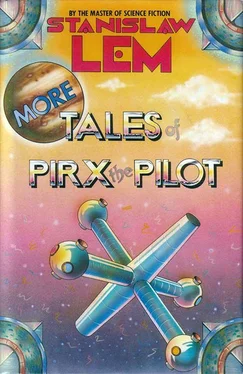When he reported at 0600 hours, he found himself a member of a nonexistent committee, their self-appointed panel having just been abolished by Earth; it was to start all over again, now officially and legally reconstituted as an adjunct to Earth’s board of inquiry. Thus dissolved, the body reaped certain advantages. It was relieved of any decision-making, and so felt freer to make recommendations to its Earthly superior.
Logistically, the situation at Syrtis Major was ticklish but not critical, whereas a suspension of deliveries would sink Agathodaemon before the month was out. Any effective help from Syrtis was out of the question. Not only were building materials in short supply, but water as well. The situation called for the most stringent economizing.
Pirx listened to the update with one ear only, because meanwhile the, Ariel’s cockpit recorder had been rescued. The human remains were being stored in containers: no decision as yet on whether they would be buried on Mars. The tapes had to be processed before they could be analyzed, which explained why matters not directly related to the causes of the shipwreck were under discussion—such as whether a mobilization of smaller freighters could save the project from extinction, guaranteeing delivery of at least minimal bio-support cargo. While Pirx saw the wisdom of such deliberations, he couldn’t help thinking of the two Mars-bound hundred-thousand-tonners, whose existence had somehow been overlooked, almost as if it was taken for granted they would have to abort. But they had to land. By now, all were keenly aware of the reaction of the American press, and radiograms kept them up-to-date on the latest political diatribes. It didn’t look good: spokesmen for the project had yet to issue a public statement, and already the administration found itself caught in a firestorm of accusation, including insinuations of “criminal negligence.” Pirx, wanting no part of it, slipped out of the smoke-filled hall around ten, and, thanks to ground maintenance, drove out in a jeep to the site of the shipwreck.
By Martian standards, it was a warm, almost cloudy day, the sky more coral-hued than rust-gray. At such times Mars seemed possessed of its own, un-Earthly, raw, slightly veiled, even soiled beauty, the sort we expected to see fully revealed, crowned with a solar radiance, from the vortex of dust and haze, though this expectation went unfulfilled—Mars’s ephemeral beauty was not a promise but the very best the planet’s landscape could muster.
Having left the squat, bunkerlike ground control a few kilometers back, they reached the end of the launch-pad area, then got hopelessly mired just beyond it. Pirx wore a lightweight partial, which they were all using up here, bright blue, much more comfortable than the full, with a backpack made lighter by an open respirator. Even so, something was wrong with the air conditioning, because the moment he started sweating from the exertion of wading through the sand drifts, his helmet visor began to fog up. Fortunately, hanging like turkey wattles between his neck-ring disconnect and his breastplate were several hand pouches that he could use to dry the glass from the inside—crude but effective.
An immense crater, teeming with caterpillars: the excavation, lined on three sides with sheets of corrugated aluminum acting as sand barriers, resembled the mouth of a mine shaft. The Ariel’ s midship—huge, like a trans-Atlantic liner storm-battered and shipwrecked against the rocks—took up half of the funnel; some fifty people bustled below her, both they and their dredging machines looking like ants on a giant’s carcass. The ship’s eighteen-meter nose section, almost intact, lay elsewhere, hurled a few hundred meters away in the crash. The force of impact had been awesome, to judge by the lumps of melted quartz: the kinetic energy had been immediately converted to thermal, producing a shock similar to that of a meteorite landing, despite a velocity less than the speed of sound. In Pirx’s mind, the disparity between Agathodaemon’s physical capacities and the enormity of the wreckage was not enough to justify the slipshod excavation; one had to improvise, of course, but the almost willful bedlam bespoke a resignation in face of the inconceivable. Even the ship’s water was wasted: with every on-board cistern ruptured, the sand had absorbed thousands of hectaliters before the remainder was turned to ice. This ice made a singularly macabre sight, gushing from the forty-meter gash in the ship’s fuselage in dirty, dazzling cascades, resting on the dunes like bizarre festoons, as if the exploding ship had spewed a frozen Niagara Falls—temperatures here reached eighteen below zero Celsius, dropping at night to sixty below. The Ariel’s ice-packed, ice-glazed hull made the wreckage look positively ancient, prehistoric.
Access to the ship’s interior was either through the ice, by drilling and jackhammering, or through the shaft. Through the latter they reached the salvageable boxes, piles of which littered the funnel’s slopes, yet the whole operation bordered on sloppy. The tail section was off limits; red pennons, strung on ropes and marking the area of radioactive contamination, fluttered furiously in the wind.
Pirx made a tour of the site, circling the lip of the embankment, and counted two thousand steps before he stood above the ship’s soot-blackened nozzles, rankling as he watched how the salvage crew, their chains slipping each time, tried futilely to pull out the one surviving fuel tank. He was there only a short while, or so it seemed to him, when someone tapped his shoulder and pointed to his respirator gauge. The pressure had fallen; since he didn’t have a spare, he had to go back. By his watch, a new chronometer, he’d spent almost two hours at the wreckage site.
The conference hall, meanwhile, had been rearranged: the locals were seated on one side of the long table, opposite six large, flat, freshly installed TV monitors. As usual, there was a glitch in the relay, so the session was postponed until 1300 hours. Haroun, the telegraph operator, whom Pirx had come across at Syrtis Major, and who, for some reason, treated him with great respect, gave him the first dubs of the tapes—the ones bearing the decisions of the power regulator—rescued from the Ariel’s shatterproof chamber. Haroun had no right to leak them, so Pirx could well appreciate the gesture. He shut himself up in his cubicle and, standing under a tensor lamp, took to examining the still-sticky snake of magnetic tape. The picture was as clear as it was incomprehensible. In the 317th second of the landing sequence, flawless until then, the control circuits showed the presence of parasitic currents, which seconds later turned up as a wiggle of beats. Twice extinguished once the load had been shifted to the grid’s parallel, back-up components, they came back intensified, and from then on, the “sensors” functioned at a rate of three times the norm. What he held in his hands was not the computer’s register, but that of its “spinal cord,” which, obeying the commands of the servo-system, coordinated the received instructions with the condition of the power routines. This system sometimes went by the name of the “cerebellum,” by analogy with the human cerebellum, which, acting as the control station between the cortex and the body, governed the correlation of movements.
He studied the “cerebellum’s” load chart with the utmost attention. The computer seemed to have been hard pressed, as if, without disturbing the operation in any way, it had demanded from the subsystems increasingly greater input per time unit. This created an informational glut and the appearance of reverberating currents; in an animal this would have been equivalent to a radically intensified tonus, a susceptibility to the motor disorders termed clonic spasms. A blind alley. True, he was missing the most important tapes, those with the computer decisions. There was a knock at the door. Pirx stashed the tapes in his grip and met Romani at the door.
Читать дальше












